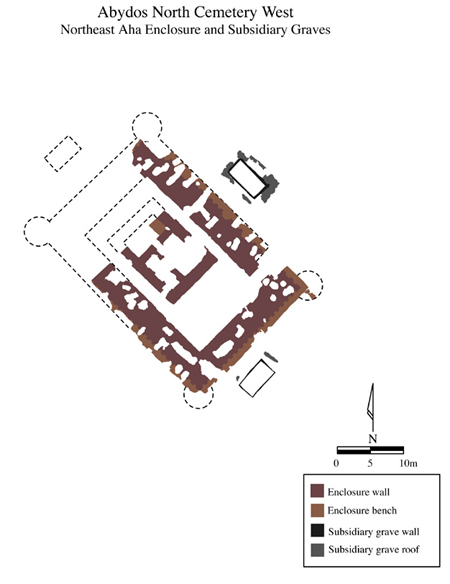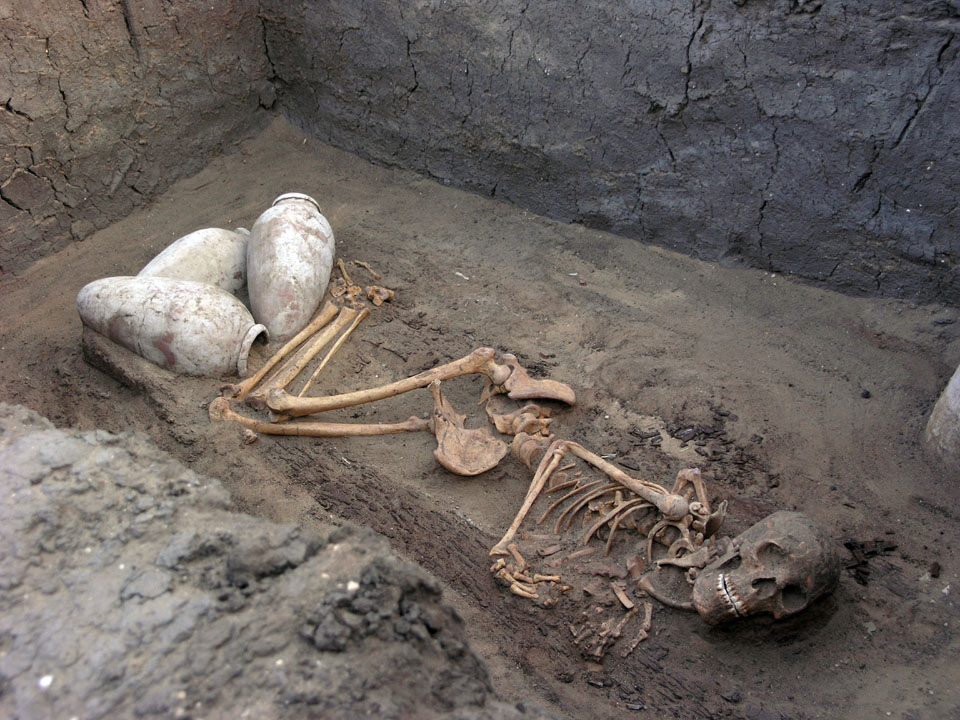|
Press Release - May 2005 |
|
|
Abydos Reveals Some of its Secrets Culture Minister Farouk Hosni announced that the treasure includes of a collection of 200 rough ceramic beer and wine jars date back to the second Dynasty that are contemporary with the original period of use of the enclosure during the reign of Khasekhemwy. The mission also stumbled upon a second mud-brick mortuary enclosure of king Hur-Aha the founder of the first dynasty along with three rectangular tombs with wooden ceiling covered with reed matting. |
|
|
|
|
|
Inside these graves another collection of pots of different shapes and sizes inscribed with hieroglyphs cited that they are fabricated in Upper Egypt during the reign of Hur-Aha, was uncovered. Inside the first tomb remains of human bones was found inside a wooden sarcophagus while the second one had a well preserved women skeleton.
Dr. Zahi Hawass secretary general of the Supreme Council of Antiquities (SCA) pointed out that while excavating the western gate of Shunet El-Zebeib, the mission uncovered remains of the mortuary enclosure wall of the Second Dynasty's king Khasekhemwy which was probably re-used later in antiquity. A collection of stone relief bearing Coptic text has been found along with a number of burials of sacred ibises date back to the Late Pharaonic period. Excavation works also extended towards the eastern side of the Shunet El-Zebeib where remains of Petrie's house are located. Within the vicinity of such house among the debris a number of artifacts were found. It includes of a letter and two postcards, possibly written by Petrie's wife to himself before his arrival to the site in 1921. At the southeastern corner, nothing of the original Second Dynasty fabric is still preserved and the remains encountered related almost exclusively to the burials of sacred ibises during Late Period. Outside the northern gateway of Shunet El-Zebib through the perimeter wall and encompassed the east gateway of the peribsen enclosure, previously excavated by the Egypt exploration society in 1903, a huge deposit of offering pottery were unearthed. "They are almost exclusively consisting of beer jars," said field director Mathew Adams in his report submitted to the SCA. He added that inside this deposit, many seal impression was also found. David O'Conner head of the mission stated that studies carried out on such
sealing impressions reveals that during Aha's reign three kinds of seals
have been used; the first bears the Aha's serekh, the second has unusual
geometrical pattern and the third has different several kinds of animals. Within the former cemetery street, another part of Aha's mortuary enclosure wall has been found and excavations inside it reveal remains of an interior cultic chapel, analogous to chapels known from others of the first and second dynasties. Adams said that the newly discovered chapel has a white plastered antechamber on the southeast that leads by a narrow doorway into a room, also white plastered, with a low bench along the northeast side, a general pattern seen also in the chapel in the enclosure of Aha excavated in 2002-2003. Both the bench and the floor of this room were covered with thick organic stains, probably the remains of offerings presented on the bench, which may represent the focal point of ritual activity. Inside this room several ceramic offering vessels and a small copper and a wooden object of unknown use were unearthed. A third room in the cult building, on the southwest side, has no wall plaster and may have served as a magazine. In addition to the new enclosure of king Aha, excavation inside the former street of the modern cemetery revealed a segment of the northeast wall of the enclosure of an unknown king of Dynasty zero discovered along with donkey burials during the 2002-2003. "This season a new funerary enclosure wall has been discovered but it is not as well preserved as the first one," Adams mentioned in his report. The west side of the wall exhibits the expected simple pattern of niching, while the east side exhibits the expected complex niches. No gateways to the enclosure are preserved nor any corners. O'Conner described such excavation executed at Shunet El-Zebib as very
important to reveal a glimpse of the early ancient Egyptian period which
its monuments are very rare. It sheds new light on both the original
design and the present condition of the enclosure wall of the second
dynasty king Khasekhenwy while both enclosure walls of king Aha have
subsidiary grave which one of them is still intact. He continued that
Evidence was also found of the use of re color for decorating the upper
parts of the white plastered wall while evidence of ritual activity was
also found in the large deposit of pottery beer jars in the northern
gateway. O'Conner asserted that such discovery adds more information to
the later history of the Shunet El-Zebib during it was used as a burial
place for sacred ibises in the late period and the Roman/Byzantine times
as the home of an early Coptic Christian monastic community. |
|
| BACK to The Plateau Homepage | |

